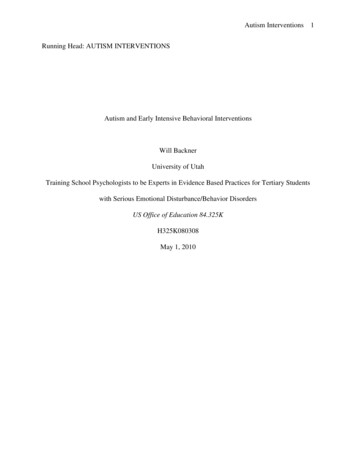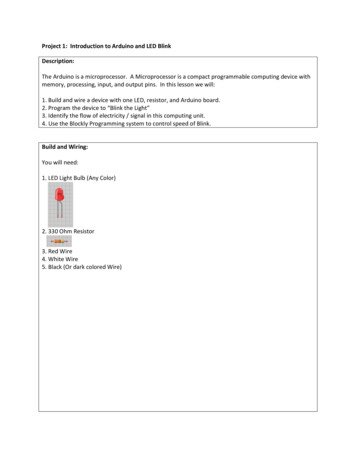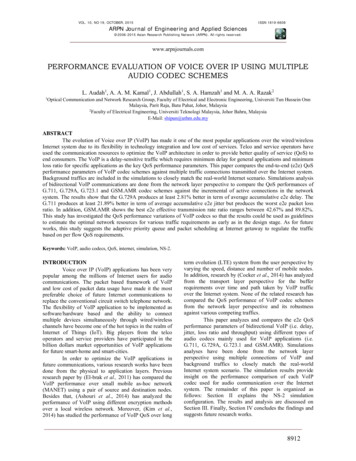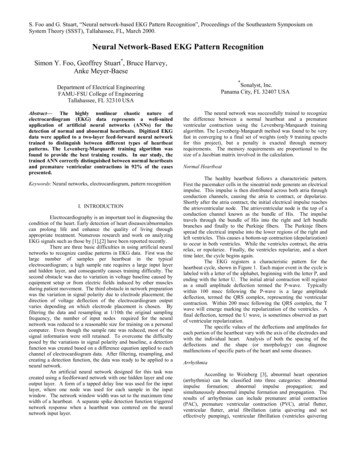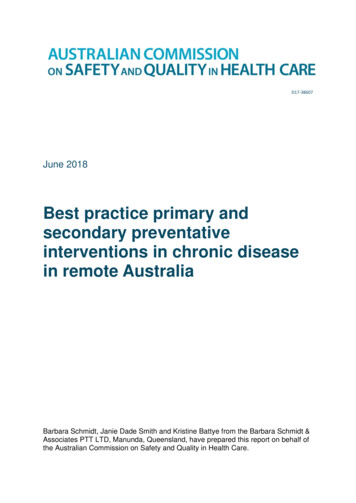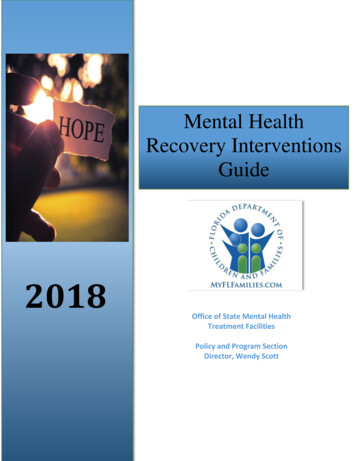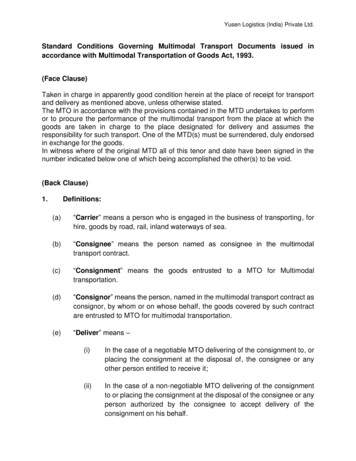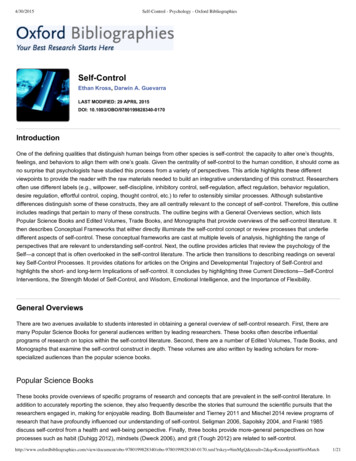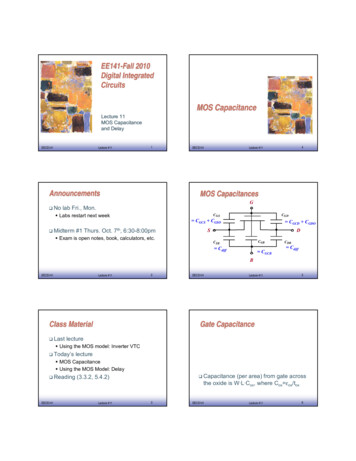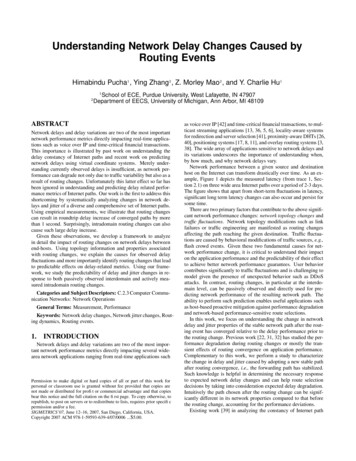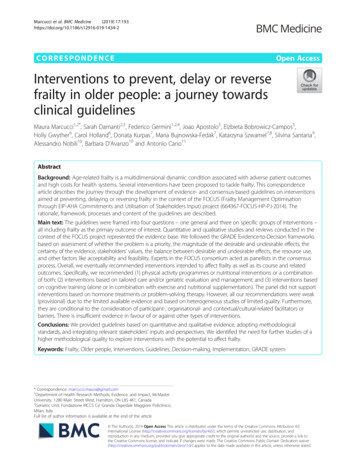
Transcription
Marcucci et al. BMC Medicine(2019) RESPONDENCEOpen AccessInterventions to prevent, delay or reversefrailty in older people: a journey towardsclinical guidelinesMaura Marcucci1,2*, Sarah Damanti2,3, Federico Germini1,2,4, Joao Apostolo5, Elzbieta Bobrowicz-Campos5,Holly Gwyther6, Carol Holland6, Donata Kurpas7, Maria Bujnowska-Fedak7, Katarzyna Szwamel7,8, Silvina Santana9,Alessandro Nobili10, Barbara D’Avanzo10 and Antonio Cano11AbstractBackground: Age-related frailty is a multidimensional dynamic condition associated with adverse patient outcomesand high costs for health systems. Several interventions have been proposed to tackle frailty. This correspondencearticle describes the journey through the development of evidence- and consensus-based guidelines on interventionsaimed at preventing, delaying or reversing frailty in the context of the FOCUS (Frailty Management Optimisationthrough EIP-AHA Commitments and Utilisation of Stakeholders Input) project (664367-FOCUS-HP-PJ-2014). Therationale, framework, processes and content of the guidelines are described.Main text: The guidelines were framed into four questions – one general and three on specific groups of interventions –all including frailty as the primary outcome of interest. Quantitative and qualitative studies and reviews conducted in thecontext of the FOCUS project represented the evidence base. We followed the GRADE Evidence-to-Decision frameworksbased on assessment of whether the problem is a priority, the magnitude of the desirable and undesirable effects, thecertainty of the evidence, stakeholders’ values, the balance between desirable and undesirable effects, the resource use,and other factors like acceptability and feasibility. Experts in the FOCUS consortium acted as panellists in the consensusprocess. Overall, we eventually recommended interventions intended to affect frailty as well as its course and relatedoutcomes. Specifically, we recommended (1) physical activity programmes or nutritional interventions or a combinationof both; (2) interventions based on tailored care and/or geriatric evaluation and management; and (3) interventions basedon cognitive training (alone or in combination with exercise and nutritional supplementation). The panel did not supportinterventions based on hormone treatments or problem-solving therapy. However, all our recommendations were weak(provisional) due to the limited available evidence and based on heterogeneous studies of limited quality. Furthermore,they are conditional to the consideration of participant-, organisational- and contextual/cultural-related facilitators orbarriers. There is insufficient evidence in favour of or against other types of interventions.Conclusions: We provided guidelines based on quantitative and qualitative evidence, adopting methodologicalstandards, and integrating relevant stakeholders’ inputs and perspectives. We identified the need for further studies of ahigher methodological quality to explore interventions with the potential to affect frailty.Keywords: Frailty, Older people, Interventions, Guidelines, Decision-making, Implementation, GRADE system* Correspondence: marcucci.maura@gmail.com1Department of Health Research Methods, Evidence, and Impact, McMasterUniversity, 1280 Main Street West, Hamilton, ON L8S 4K1, Canada2Geriatric Unit, Fondazione IRCCS Ca’ Granda Ospedale Maggiore Policlinico,Milan, ItalyFull list of author information is available at the end of the article The Author(s). 2019 Open Access This article is distributed under the terms of the Creative Commons Attribution 4.0International License (http://creativecommons.org/licenses/by/4.0/), which permits unrestricted use, distribution, andreproduction in any medium, provided you give appropriate credit to the original author(s) and the source, provide a link tothe Creative Commons license, and indicate if changes were made. The Creative Commons Public Domain Dedication o/1.0/) applies to the data made available in this article, unless otherwise stated.
Marcucci et al. BMC Medicine(2019) 17:193BackgroundFrailty and its impactThe term ‘frailty’ has been used to describe an agerelated state of decline and vulnerability characterised byweakness and decreased physiological reserve [1]. Frailolder adults are less able to adapt to stressors such asacute illness, surgery, trauma or bereavement, and are atincreased risk of falls, institutionalisation, disability anddeath [2, 3]. The concept of frailty has been operationalised through different definitions to help clinicians, researchers and other stakeholders to identify frail olderpatients. One of the most commonly adopted definitionsis the one used in the Cardiovascular Health Study,known as the Frailty Phenotype or Physical Frailty. It isbased on five criteria related to reduced physical reserve,and defines frail and prefrail states based on the numberof criteria met [1]. Others sustain a different approach,which views frailty as a multidimensional risk state defined by the accumulation of deficits in different domains, such as cognition and mood, chronic diseases,polypharmacy, functional autonomy and social conditions, using a continuous scale as opposed to categoryassignment. The Frailty Index by Rockwood et al. [4] istaken as a paradigm of this second approach.Although the use of different definitions leads to theidentification of different target populations and leads toa variation in the estimate of the actual prevalence ofPage 2 of 11frailty [5, 6], the associations between frailty, adverseoutcomes, and health and social care utilisation havebeen invariably demonstrated. This has been commonunderstanding for more than a decade [7] and has led toseveral initiatives to tackle frailty and its relatedoutcomes.The FOCUS projectTo add to the international efforts to reduce the impact offrailty, we conducted the FOCUS (Frailty Management Optimisation through EIP-AHA Commitments and Utilisationof Stakeholders Input) project, funded by the EuropeanUnion’s Third Health Programme (2014–2020) [8, 9]. Theproject included a series of quantitative and qualitativestudies [10–16] (Table 1), which, through the review andappraisal of the literature and the collection of stakeholderinputs, served the project mission of providing instrumentsto guide the implementation and scaling up of effectivestrategies of frailty prevention and management. The development of clinical guidelines represented an ultimate important achievement in the fulfilment of this mission.The need for clinical guidelinesAt the time of designing our project, we recognised theneed to offer patients, their formal and informal carers,healthcare practitioners, and decision-makers a scientificsupport to their actions, by bringing together scientificTable 1 The FOCUS evidence base and its relevance in the assessment of interventions targeting frailty based on the Evidence-toDecision (EtD) criteriaFOCUS project deliverablesaEvidence typeEtD criteria for which the evidencewas considered relevantSystematic review of the effectiveness ofinterventions on frailty (D4.1.2) [11]Quantitative: A systematic review of randomised studies oninterventions on frailty in older people, including healtheconomy studiesBenefits, harms, resource use, costeffectiveness, equityReview of qualitative studies on frailtyinterventions with stakeholders(D4.1.3) [12]Qualitative: A meta-synthesis of qualitative studies onstakeholders’ views and experiences of care andinterventions in the context of frailtyOutcome importance, value, equity,acceptability, feasibilityThematic summary of focus groups withstakeholders in three different EU states(D4.1.4) [13]Qualitative: An inductive thematic analysis of semi-structuredfocus groups and individual interviews in three Europeancountries (Italy, Poland, UK) with five groups of stakeholders,including frail and non-frail older adults, family caregivers,and health and social care professionalsOutcome importance, value, equity,acceptability, feasibilityThematic summary of joint focus groupswith EU policy-makers (D4.1.5) [14]Qualitative: An inductive thematic analysis of semi-structuredinterviews with seven healthcare policy-makers across EuropeOutcome importance, value, equity,acceptability, feasibilityStructured survey of partners within theEIP-AHA (D4.1.7) [15]Mixed: A structured survey seeking the opinions of EIP-AHApartnersOutcome importance, value, equity,acceptability, feasibilityRealist review (D4.1.8) [16]Mixed: A realist review combining findings from the differentcomponents to examine what works, for whom and inwhat circumstancesOutcome importance, value, equity,acceptability, feasibilityComprehensive report of the results of the Quantitative: Comparative analyses of EIP-AHA commitmentsResource use and feasibility (additionalcomparative analyses and modellingupon structure, process and outcome indicators; modellingconsiderations)(FOCUS internal deliverable D5.2.1–5)analyses of significant predictors of outcome, health and socialcare needs and use in the frame of frailty, with projected impactof changes in frailty as a result of interventionsEIP-AHA European Innovation Partnership on Active and Healthy Aging, EU European UnionaDeliverables are enumerated and titled based on FOCUS Grant Agreement
Marcucci et al. BMC Medicine(2019) 17:193evidence and stakeholder perspectives into recommendations that responded to the definition of clinicalguidelines [17, 18]. In fact, as the interest in the conceptof frailty had also grown outside the internal and geriatric medicine field, we had seen several non-geriatric scientific societies including special considerations on themanagement of the disease(s) of interest related to olderfrail patients in their clinical guidelines [19–22]. However, within the specific field of frailty as a syndrome,when the FOCUS consortium started its work in 2015,there were no clinical guidelines generated from rigorous methods recognised as standards by the scientificcommunity, which would give frailty the dignity of otherclinical conditions [23]. Therefore, we translated ourFOCUS project mission into the development of evidence- and consensus-based guidelines, intended for allthose involved in decision-making and implementationof actions on frailty.This correspondence article presents the developmentprocess of our FOCUS guidelines, providing their justification, with emphasis on their novelty, limitations andimplications.Main textDefinition of the clinical questions: frailty as an outcomeWe started by formulating the questions to be answered by the guidelines, based on the PICO format[24] (Table 2). While the project covered the entirespectrum of relevant clinical questions on frailty, including screening and diagnostic strategies [10], wedecided to focus the guidelines on the role of interventions to prevent, delay or revert frailty. We framed theguidelines according to a hierarchical structure. Weincluded a first question (General Question, GQ) asking whether the overall current evidence and stakeholder inputs support interventions meant to affectfrailty and its course, followed by the addition of subquestions (Questions 1–3 (Q1–Q3)) focused on specific types of interventions. For each question, twopopulation subgroups were also considered, i.e. frailand prefrail subjects. The choice of the outcome andits definition represented the most sensitive step inthe formulation of our PICO questions. We prespecified ‘frailty’ as our primary outcome, in compliancewith the FOCUS project mission and the intention totreat frailty as a syndrome; we reflected the choicepreviously made in the definition of the study inclusion criteria for our systematic review of randomisedcontrolled trials on interventions to prevent or reducefrailty [11]. Specifically, in our systematic review, weincluded studies that looked at the effect of interventions on frailty defined according to any validatedscale, index, indicator or sets of indicators that wereexplicitly adopted by the authors as a definition forPage 3 of 11Table 2 FOCUS guideline questions in the PICO formatGQ – Should interventions to prevent or delay the progression of frailty,or to reverse frailty, be adopted in prefrail or frail older people?Q1 – Should physical interventions be recommended to prevent ordelay the progression of frailty, or to reverse frailty, in prefrail orfrail older people?Q2 – Should interventions based on tailored care and/or GEM berecommended to prevent or delay the progression of frailty, or toreverse frailty, in prefrail or frail older people?Q3 – Should other interventions be recommended to prevent or delaythe progression of frailty, or to reverse frailty, in prefrail or frailolder people?Patients: People aged 65 years or older, defined as prefrail or frailaccording to a pre-specified scale, index or criteria, not at the end-of-lifephase or selected because of an index diseaseInterventions:GQ: Any intervention explicitly defined as an intervention for frailty(regardless of the definition of frailty used)Q1: Physical interventions Interventions based on exercise/physical activity Nutritional interventions (e.g. diet change, supplementation) Exercise/physical activity combined with nutritional interventionsQ2: Interventions based on tailored care and/or GEM Uni-professional interventions based on tailored care/GEM Multidisciplinary interventions based on tailored care/GEMQ3: Other interventionsa Cognitive training A composite of exercise nutritional supplementation cognitivetraining Exercise nutritional consultation Problem-solving therapy Hormone therapy OthersReference intervention: No intervention or placebo or usual careOutcomes: Frailty – defined according to a composite index, or based onphysical performance tests commonly related to the ‘frailty’definition (SPPB, TUG, gait speed, handgrip strength) Other relevant patient important outcomes – cognitive performance,functional performance, other measures of physical performance,quality of life, depression, self-perceived health, social engagement,caregiver burden, falls and fractures, mortality, hospitalisation, institutionalisation, comorbidity burden, drug prescriptionSetting: Any (community, primary care, nursing homes, hospitals)Perspective: PopulationGEM geriatric evaluation and management, GQ general question, Q question,SPPB short physical performance battery, TUG time up and goaThe provided list of interventions includes interventions evaluated in studiesfound in our systematic review [12] that did not match Q1 and Q2 definitions;it does not include any other possible interventionfrailty [11]. However, our systematic review and guidelines also considered and evaluated the effect onfrailty-related outcomes, which we defined as our secondary outcomes, including cognitive performance,ability to perform activities of daily life and quality oflife, among others [11].Selection of a framework: GRADE and Evidence-toDecisionWe adopted the GRADE (Grading of RecommendationsAssessment, Development and Evaluation) WorkingGroup system to assess the certainty of evidence and define the strength of related recommendations [25, 26]. In
Marcucci et al. BMC Medicine(2019) 17:193particular, we followed the Evidence-to-Decision (EtD)framework, which was developed by the GRADE Working Group to support the process of moving from evidence to decisions, in the contexts of making clinicalrecommendations or coverage, health system, or publichealth decisions [27]. It has been implemented as aninteractive online tool (iEtD) that can support aconsensus-based process, which we used [28]. Theframework suggests a list of criteria upon which the intervention(s) of interest should be assessed based on research evidence, namely whether the problem is apriority, the magnitude of the desirable and undesirableeffects, the certainty of the evidence, how patients (orothers affected, such as carers) value the main outcomes,the balance between desirable and undesirable effects,resource use, acceptability, and feasibility [27].FOCUS evidence baseThe development of our guidelines was preceded by aseries of quantitative and qualitative studies performedwithin the FOCUS project, reported in separate publications [11–16], which represented the evidence base forour judgments and recommendations. In particular, weperformed a systematic review of randomised controlledtrials evaluating interventions on frailty, which represented our quantitative evidence base [11]. As a supportto the consensus process, the relevant results of the systematic review were synthesised into tables, one for eachof the sub-questions (Additional file 1). The tables focusedon the effect of interventions on frailty as an outcome, according to different frailty definitions and based on thetypical GRADE Summary of Findings table structure [25].The effect of interventions on the secondary outcomeswas narratively synthesised (Additional file 2). We alsoperformed a realist review [16], using the approach of theRealist and Meta-narrative Evidence Synthesis: EvolvingFig. 1 Steps of the FOCUS guideline development processPage 4 of 11Standards (RAMESES) project [29] and integrating the results of the systematic review with other FOCUS studies,to try to respond to the question “what works, for whomand in what circumstances’; this realist review representedthe base for our recommendations on implementation (i.e.the conditions for the intervention to succeed). These andthe other FOCUS studies are listed in Table 1, togetherwith their relevance to the EtD criteria used to developthese guidelines.Consensus processThe guideline panel included the FOCUS project investigators with a background in health and social sciencesas well as expertise in frailty, aging and health researchmethods. Most of them are members of the EuropeanInnovation Partnership on Active and Healthy Ageing(EIP-AHA) [30]. Table S1 in the Additional file 3: TableS1 lists the FOCUS investigators, their professional profile and their role in guideline development. We undertook a multistep approach, as schematised in Fig. 1. Thetechnical team (Table S1) conducted a preliminary appraisal of the evidence base upon the iEtD criteria andsubmitted it to the panel using the iEtD tool. The panelwas asked to revise this appraisal and to make theirjudgment on the existing evidence for each question,upon each criterion. In particular, the judgement wasguided by criterion-specific questions (e.g. ‘How substantial are the desirable anticipated effects?’) that thepanel had to answer using an ordinal scale. Voting wasanonymous. Panel discussion was also encouraged viaemail. The technical team collated the panel’s judgmentsand comments. A draft consensus judgement for eachcriterion and for each question was determined based onthe mode and median rating. Any non-coincidence between mode and median rating was considered semiquantitative proof of skewness of the votes, suggesting
Marcucci et al. BMC Medicine(2019) 17:193the need for discussion with the panel. Even when modeand median coincided, a note (e.g. ‘ ’ or ‘–’) was addedto the draft consensus statement in the case of significant heterogeneity in the vote distribution.Of the 13 FOCUS project investigators who were giventhe role of voting panellists, 11 participated in the votingprocess. All criteria for all questions were covered by thevoting, but with a few missing votes, which were evenlydistributed across criteria and questions. We provide anexample of the voting outcome, based on the iEtD output and with the addition of the panel’s comments andtechnical team’s annotations (Additional file 4). Thelevel of agreement was generally very good, but variedslightly across questions and criteria; it was higher forGQ (the highest) and Q1 compared with Q2 and Q3. Although initially all the EtD criteria were judged relevantfor guideline development, the FOCUS panellists considered the existing evidence upon the criteria of resourceuse and cost-effectiveness, as collected in the frame ofthe FOCUS project, insufficient to use these criteria tojustify their recommendations (Additional file 5). Subsequently, the main point raised by the panel during thediscussion was the necessity to put more emphasis onwhat had been learned from the qualitative evidencebase, and in particular from our realist review, whichcombined qualitative and quantitative evidence [16].This translated into a final version in which the suggestions on how to implement interventions to increase thechance of success were included in the core of theguidelines, rather than only as additional considerations.Finally, the attribute of ‘conditional’ for recommendations, as opposed to ‘strong’, was preferred over ‘weak’to emphasise that the recommendation is conditional toconfirmation from further evidence and/or conditionalto implementing facilitators or overcoming barriers.FOCUS guidelines and their justificationTable 3 presents the final FOCUS Recommendations (R)on interventions to prevent or delay the progression offrailty, or to reverse frailty, in response to the four questions, i.e. RG (‘G’ for general), R1, R2, and R3. Below, weoffer a justification, subgroup considerations and otherconsiderations related to monitoring and evaluation, foreach guideline. In Additional file 5 we provide a detailedjustification for the judgement on each criterion for eachguideline.RG – We suggest implementing interventions specifically intended to have an impact on frailty inolder age, i.e. preventing or delaying the progressionof frailty or reversing frailty (conditional strength ofrecommendation).Justification. The recommendation stems from the belief,common among different stakeholders and endorsed by thePage 5 of 11guideline panel, that frailty as an outcome is important andthat interventions explicitly conceived to address it areneeded. We found some quantitative evidence for differentinterventions being associated with delaying the progression of frailty or reverting frailty, although the effects weremoderate in their size at maximum. These interventions,based on either a mainly physical concept of frailty or on amore comprehensive view, could be potentially fair, acceptable and feasible from a population perspective. However,the strength of this recommendation is weak/conditionalbecause of the low certainty/quality of the quantitative evidence, due to substantial study limitations, inconsistencyand heterogeneity across studies (different populations, interventions, outcome definition, and settings/contexts) aswell as imprecision of the estimates.Subgroup considerations. The level or extent of frailtywas expected to act as an effect modifier of interventionson frailty, i.e. affecting their relative effect, because ofseveral reasons. For instance, some interventions are expected to work only or more in the presence of a certaindeficit status. On the other hand, being frailer mightaffect the opportunity to benefit from interventions thateither require an active participation or work only in lesssevere illness states. In fact, among the studies examinedin our systematic review [11], those that found significant benefits on frailty progression included participantsbelonging to a range of levels of frailty and ages. It wasdifficult to look at the effect of the level of frailty as apredictor of an intervention to succeed since the heterogeneity across studies upon several aspects meant thatthe role of the level of frailty could have been confounded by other possible predictors such as the level ofcompliance or adherence to the intervention. Moreover,even if some of the authors themselves supposed or perceived there to be a window for the intervention to workaccording to the level of frailty or disability of participants, this hypothesis was not systematically explored inany study.Considerations on monitoring and evaluation. Thepanel judged the implementation of strategies to monitor (and then improve) the adherence to the interventionas important, in particular in the case of interventionsthat require an active participation of the older person.The need to implement an effective evaluation plan ofthe interventions was also emphasised. In the FOCUSproject, we aimed to analyse the initiatives (i.e. commitments or Good Practices) within the EIP-AHA [30] inorder to study the relationship between the outcomes ofthese initiative and feasibility aspects (barriers and facilitators), resources and processes (Table 1). In this context, we found that many initiatives were undertakenwithout any plan for evaluation, e.g. assessment of their
Marcucci et al. BMC Medicine(2019) 17:193Page 6 of 11Table 3 FOCUS guidelinesGQ – Should interventions to prevent or delay the progression of frailty, or to reverse frailty, be adopted in prefrail or frail older people?Recommendation RGConditions for the intervention to succeed [14]We suggest implementing interventions specifically intended tohave an impact on frailty in older age, i.e. preventing or delayingthe progression of frailty, or reversing frailty (conditional strengthof recommendation)Participant factors Co-create the details of interventions with intended recipient groups Consider the level of frailty of participants Employ best practice health psychology behaviour change strategies Consider group and fun, rewarding interventions wherever possible Determine whether the intervention is only appropriate if a specificdeficiency is present, e.g. nutritional deficiency Before implementing an intervention, consider correcting deficienciesthat can interact with the intervention’s working mechanisms Address understanding and attitudes towards malleability of frailty ofpatients before the intervention Address self-efficacy in the intervention activity Consider accessibility of locations to individuals Employ approaches that are person, family and ‘lifeworld’ centred Include social and psychological wellbeing factorsOrganisational factors Co-create the details of interventions with intended delivery practitioners Ensure training to emphasise implementation fidelity and standardisationof delivery Address practitioners’ understanding and attitudes towards the malleabilityof frailty before the intervention Consider expectations of older adults’ commitment and ability to participate Provide some training in health psychology componentsCountry/contextual/cultural factors Consider the suitability of the intervention for your context(e.g. clinical, community, inpatient, outpatient) Consider likely cultural preferences, e.g. for expert-led or self-directedinterventions Consider what ‘normal care’ is in your context Consider the level of existing health literacy in your populationQ1 – Should physical interventions be recommended to prevent or delay the progression of frailty, or to reverse frailty, in prefrail or frailolder people?Recommendation R1Conditions for the intervention to succeed [14]We suggest implementing physical interventions, including physicalactivity/exercise, nutritional interventions, and a combination ofexercise and nutritional interventions, to prevent or delay theprogression of frailty, or to reverse frailty (conditional strength ofrecommendation). The recommendation is stronger for group-basedsupervised exercise programmes, either alone or in association withnutritional supplementationAmong the factors to consider when an intervention on frailty isimplemented, those which are particularly relevant in the case of physicalinterventions are: Consider implementing those factors that can increase participants’acceptance of and, as a consequence, compliance to the intervention,i.e. the inclusion of elements favouring or promoting socialisation, fun,accessibility, self-efficacy and commitment. Among those factors,consider the implementation of group-based exercise programmes andsupervision by professionals with adequate training; in general, includeprofessionals with adequate skills in health psychology andcommunication; the inclusion of these elements might affect theadherence to the intervention Consider the characteristics of the participants to whom the interventionwill be directed, for example, the presence of deficits that make theintervention necessary, and the level of expected compliance. The levelof frailty particularly may have an important impact, not least because it islikely to be associated with these other characteristics Even though physical interventions for physical components of frailty areappropriate, considering the person as a whole, including, for example,their psychological wellbeing and functions and their social context,may be beneficial The opportunity to take into account and include these elements mightaffect the feasibility and suitability of the interventions in each specificcontext
Marcucci et al. BMC Medicine(2019) 17:193Page 7 of 11Table 3 FOCUS guidelines (Continued)Q2 – Should interventions based on tailored care and/or GEM be recommended to prevent or delay the progression of frailty, or toreverse frailty, in prefrail or frail older people?Recommendation R2Conditions for the intervention to succeed [14]We suggest implementing interventions based on tailored careand/or GEM, to prevent or delay the progression of frailty, or toreverse frailty (conditional strength of recommendation).The recommendation is stronger for GEM-based interventionsinvolving a multidisciplinary team, especially in inpatient clinicalsettings, but still conditional to the confirmation from furtherstudies of good qualityAmong the factors to consider when an intervention on frailty isimplemented, those of particular relevance to interventions aimed at amore comprehensive concept of frailty: Consider the context (the clinical setting, usual care, cultural preferences) Co-create the details of interventions with inte
known as the Frailty Phenotype or Physical Frailty. It is based on five criteria related to reduced physical reserve, and defines frail and prefrail states based on the number of criteria met [1]. Others sustain a different approach, which views frailty as a multidimensional risk state de-fined by the accumulation of deficits in different do-
